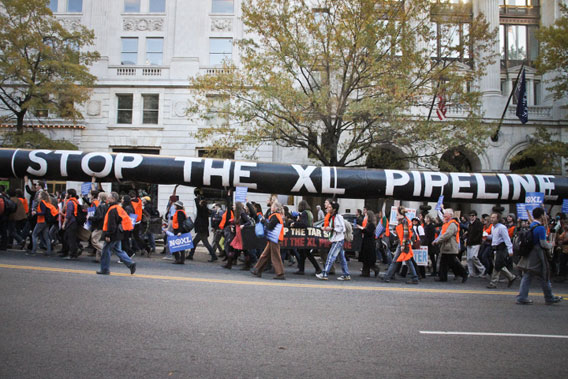
Around 12,000 protestors surrounded the White House, some carrying a symbolic pipeline. Photo by: Clayton Conn.
One year to the day before the 2012 US election, up to 12,000 activists encircled the White House to protest the Keystone XL pipeline, a proposed 1,700 mile pipeline that would carry oil from Canada’s infamous tar sands to the US and other foreign markets. Critics of the TransCanada pipeline have warned of potential spills in America’s heartland as well as the climate impacts of allowing more tar sands oil, which has a higher carbon footprint than conventional sources, into the US and other markets. The issue has galvanized climate and environmental activists in the US with the massive rally on Sunday preceded by civil disobedience actions in late summer that lead to the arrests of 1,253 people.
“[It] would be another dirty needle feeding America’s fossil fuel addiction,” Jamie Henn, spokesperson with Tar Sands Action, which organized the protests, and co-founder of climate organization 350.org, told mongabay.com last month. “The pipeline would carry tar sands oil from Alberta to the Gulf of Mexico. Along the way, it would cross the Ogallala Aquifer, risking an oil spill over one of our largest sources of fresh drinking water and the source of 30 percent of the irrigation water for America’s crops. […] for the climate. Politically, the pipeline is also a bad call: it’s a hand out to Big Oil and people like the Koch Brothers who have consistently used their profits to corrupt our political system.”
At the rally protesters, from young to old, chanted ‘yes we can stop the pipeline’. Signs ranged from ‘No Oil in Our Soil’ to ‘What would Sasha and Malia say’ to reprinting past quotes of President Barack Obama, such as, ‘Let’s be the generation that finally frees America from the tyranny of oil’.
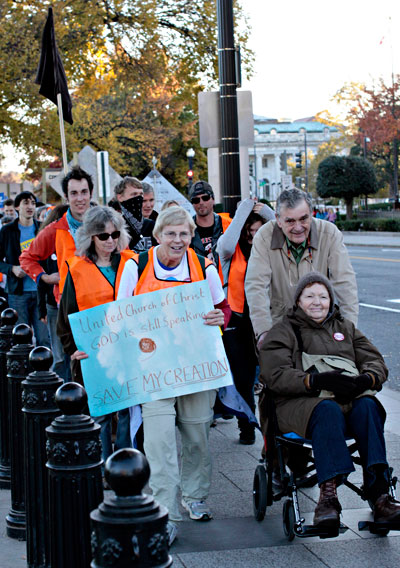 Protestors with church group. Photo by: Emma Cassidy. |
The president has noted that he will make the final decision on the pipeline with input from the State Department. He recently addressed the issue in Nebraska, one of six states through which the pipeline will travel: “I think folks in Nebraska, like all across the country, aren’t going to say to themselves, ‘We’ll take a few thousand jobs if it means that our kids are potentially drinking water that would damage their health.'” A decision is expected by the end of the month. Though many are saying the protests may force the administration to delay the decision for a year—until after the next election.
For many activists, the crux of the issue is climate change.
“From a carbon perspective the project is filthy and the last thing in the world a rational person would approve,” one of those attending, Paul Rosolie, told mongabay.com. “I attended the rally because I think it is important to remind President Obama that he was elected by people who want change, to move away from fossil fuels. Not everyone can take the time out of their lives to travel to Washington to remind the President, but still 12,000 people came, each one of them a representative of millions—both around the world and in generations to come.”
In terms of carbon emissions, Cambridge Energy Research Associates (CERA) estimated the greenhouse gas emissions of the tar sands was 5-15 percent higher than conventional sources, while the International Energy Agency (IEA) found that emissions were 20 percent higher. Others have given higher numbers. Climatologist, James Hansen, has stated that if the full-extent of the tar sands are exploited along with the world’s coal reserves ‘it is essentially game over’ for the climate. Opening up the tar sands to foreign markets through the Keystone XL pipeline would increase expansion in Canada, while canceling the pipeline would force TransCanada to seek another route, a problem that could stall expansion indefinitely.
Proponents of the pipeline say that it will allow the US to have a secure source of oil coming from a friendly nation and will create thousands of jobs.
“What these millionaire actors and professional activists do not seem to understand is that saying no to Keystone means saying yes to more conflict oil from the Middle East and Venezuela filling American gas tanks,” TransCanada spokesman James Millar said, referring to Hollywood actors, such as Mark Ruffalo, who spoke to the crowd yesterday. TransCanada initially estimated the pipeline would create around 5,000 jobs, but since then has boosted that to 20,000, though opponents say this job figure was pulled out of thin air.
The tar sands issues is controversial in Canada as well. The exploitation of the region has led to water pollution, political conflict with First Nations people, and large-scale deforestation in the Boreal. In addition, the rising emissions from exploiting the tar sands have forced Canada to back-off its climate goals.
Conflict-of-interest?
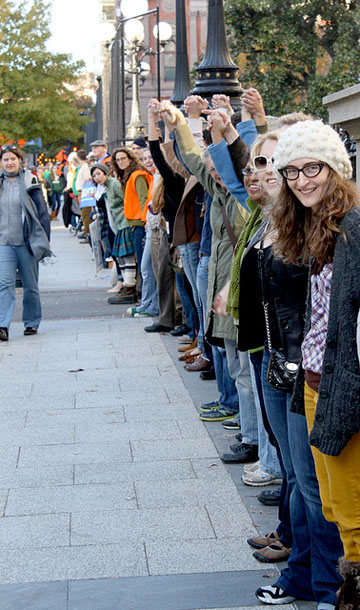 Protestors create human chain around White House. Photo by: Emma Cassidy. |
Meanwhile, the issue has become complicated by recently released emails showing an allegedly cozy relationship between the State Department and TransCanada lobbyists. A relationship, critics say, that has corrupted the entire review process.
In addition, the New York Times recently reported that TransCanada hand-picked the consulting firm that oversaw the Environmental Impact Assessment (EIA), which environmentalists criticized for not addressing the issues of greenhouse gas emission at all, and for painting a rosy picture of possible oil spills.
“The State Department should recuse itself from the Keystone XL decision and the whole permit process should be scrapped. […] President Obama pledged to have “the most transparent government in history.” This runs completely contrary to that promise,” Henn said of recent revelations.
Climate failure
Many environmentalists have long been frustrated with the Obama Administration for its failure to take serious steps to tackle climate change. The agreement reached in Copenhagen with Obama’s last-minute arrival was considered by most as lackluster; then, after losing a bid to enact federal climate legislation, the administration appeared to drop climate change as a priority. President Obama appeared reluctant for a time to even mention the words ‘climate change’.
Meanwhile, warnings from scientists regarding climate change have become graver. A study in Nature last month found that nations are running out of time in their pledge to keep temperatures from rising above 2 degrees Celsius, while a leaked report from the Intergovernmental Panel on Climate Change (IPCC) found that there is a 2-in-3 chance that climate change is already worsening severe weather worldwide, perhaps contributing to the number of bizarre weather-related disasters over the past few years, including unprecedented drought in Texas, a killer heatwave in Russia, and record flooding in Thailand to name just a few. Still global greenhouse gas emissions continue to rise, with recent data from the US Department of Energy (DOE) revealing a 6 percent rise (564 million additional tons of carbon) worldwide in carbon emissions connected to burning fossil fuels from 2009 to 2010. Emissions in 2010 amounted to 33.5 billion metric tons of carbon dioxide.
Protestor Rosolie said that Bill McKibben, one of the rally’s organizers and a hugely-influential climate activist, argued in a speech that in order for the US to have influence worldwide on climate change and the environment, it must finally address these problems at home.
“In the wake of his words was the realization that our precedent would impact our ability to affect change for so many other struggles,” Rosolie said. “I thought of the Belo Monte dam, the Serengeti highway, the Trans-Amazon highway, the Mekong, the mountain gorillas, the Sumatran rhinos, the Kayapo… [McKibben] was right; this issue is make or break on so many levels, both nationally and internationally, today and for the future.”
For its part the Obama Administration says it is well aware of the pros and cons of the pipeline, and the president will weigh these in his decision. But until the protests started in late summer, many considered the approval of the pipeline a foregone conclusion.
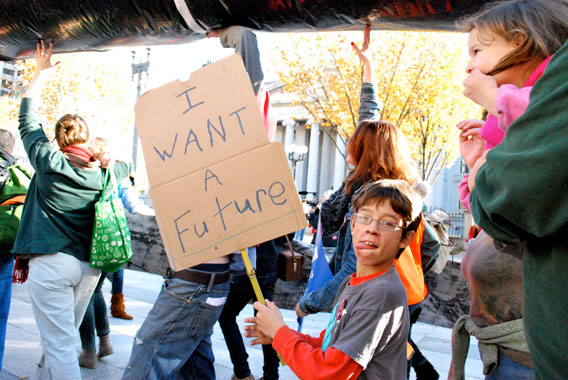
Protestors included kids. Photo by: Amy Dewan.
Related articles
Tar sands pipeline ‘another dirty needle feeding America’s fossil fuel addiction’
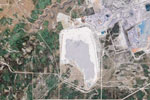
(10/11/2011) Climate and environmental activism in the US received a shot of enthusiasm this summer when it focused unwaveringly on the Keystone XL Pipeline. During a two week protest in front of the White House, 1,253 activists—from young students to elder scientists, from religious leaders to indigenous people—embraced civil disobedience for their cause and got themselves arrested. Jamie Henn, spokesperson with Tar Sands Action, which organized the protests, and co-founder of climate organization 350.org, told mongabay.com that,”the reason the Keystone XL pipeline has emerged as such a key fight is because it is on a specific time horizon, the Administration says it will issue a decision by the end of this year, and the decision whether or not to grant the permit rests solely on President Obama’s desk. This is a clear test for the President.”
Keystone pipeline company hand-picked US government’s environmental assessor
(10/10/2011) A little over a month after 1,252 people were arrested in two weeks of civil action against the Keystone XL Pipeline, The New York Times has revealed that the Obama administration allowed a consulting firm with financial ties to the pipeline to conduct the project’s Environmental Impact Assessment (EIA). While it is not uncommon for government departments to ‘outsource’ EIAs, legal experts quoted in the piece expressed surprise that the State Department would select a firm so close to the company proposing the project.
Climate test for Obama: 1,252 people arrested over notorious oil pipeline

(09/06/2011) Two weeks of climate disobedience at the White House ended over the weekend with 1,252 people arrested in total. Activists were protesting the controversial Keystone XL pipeline in an effort to pressure US President Barack Obama to turn down the project. If built the pipeline would bring oil from Alberta’s tar sands through six US states down to Texas refineries. While protestors fear pollution from potential spills, especially in the Ogallala Aquifer which supplies water to millions, the major fight behind the pipeline is climate change: Canada’s tar sands emit significantly more carbon than conventional sources of oil.